Hello, company: it has reached our virtual ears that you want to enter the wonderful world of the metaverse (special company edition). No wonder; the metaverse for companies is the most talked-about thing lately. We can see in the news that people, with or without companies, are starting to ‘move’ into this world. It sounds very futuristic, but the possibility of having a second life in a virtual and hyper-real world is within the reach of many people and groups.
We can think of the metaverse for companies as a new world to discover (and conquer). What started as an idea and continued as a game that no one took seriously has become the goal of all companies, large and small. And this virtual reality offers opportunities to any type of business, from startups to business giants (such as Microsoft).
However, and although at Cronuts we are all very ‘fans’ of the metaverse, we assume that you, little big company reading this post, need a spiritual guide, something to be your white rabbit to Wonderland. Fear not, as we have already set to work to create the Metaverse Guide for Businesses.
Post-real, metaverse, avatar… where does it all come from?
Let’s enter the world of the metaverse for companies little by little. When you became interested in this post-reality you probably started reading terms like the ones in the title of this section, right? But to understand the future of the metaverse we must understand its past. We have to make a special mention to Neal Stephenson, writer from whom we take terms such as metaverse or avatar (no, James Cameron did not invent it) that appear in his book Snow Crash (1992), where he already dealt with issues about parallel and virtual realities with avatars as a means of communication between both worlds. Have you seen the movie
Ready Player One
The metaverse would be that virtual world that the protagonist sees every time he puts on his glasses. In fact, it illustrates it quite well, only today we still don’t have those epic races and the excitement of an action movie.
Let’s say that the metaverse for companies is a virtual reality that can also be made to become augmented and/or virtual reality. It is a means of communication that has grown to create a parallel existence to physics. In fact, many brands have seen the vein of the metaverse and are present in it (Samsung, Hyundai, Coca-Cola, Gucci…) as if it were the same reality.
To get an idea of the size of the sector, a total of $57 billion was invested in the metaverse in 2021. By 2022, more than twice as much will be invested, i.e. $120 trillion, but a recent McKinsey study estimates that investment in the metaverse in 2030 will be $5 trillion. To put these figures in context, a total of $29.5 trillion was invested in cybersecurity in 2021. In other words, by 2021, almost twice as much was already invested in metaverse-related technologies.
But what does a company look like in a virtual reality? Let’s put it this way: if the metaverse has literally become a universe that copies the reality around you, isn’t it logical that the services or products you buy and use are also present virtually? Your avatar may need things or require certain services and have them available if those companies that offer them are not part of that universe. Or maybe you simply want to explore all the possibilities the metaverse for companies has to offer, browsing and discovering what it has to offer. It is an extreme evolution of the web, developed by mechanisms based on cryptography and blockchain. Check out this sneak peek of the metaverse wallets . These are the virtual wallets that store the money you have wanted to use within the virtual universes (which we will explain below). As you can see, they have only gone up over the last year:
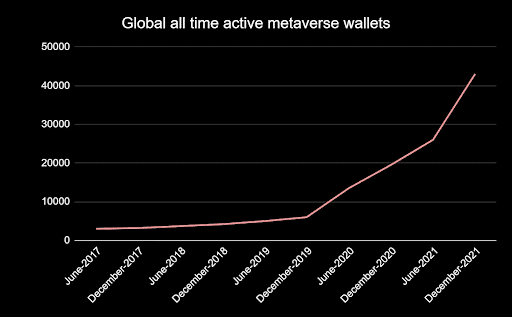
Surely all those words we have just said don’t matter to you at all and what you want is to design your avatar, like in the Sims. We are sorry to tell you that the three-dimensional environments, in reality, are not the most important or central focus of the metaverse for companies, but rather the ability it has to offer greater freedom and control to the user. And that freedom is rubbing off on companies, which will begin to evolve into more decentralized and autonomous organizations. In fact, many companies are catching up with this whole issue because they can live in the metaverse as such (Puma, UAE Airliner Emirates, Mc Laren).
What does the metaverse for companies do?
This world to be explored has a lot of good things and, like everything else, some bad things (we don’t want to lie to you). As this post is a guide to the metaverse for companies we are going to perform a super SWOT analysis to expose the cool and not so cool things that the metaverse offers for your business, as it can:
Help you strengthen:
- Brand image and recognition
- Retention of existing customers
- The new ways of interacting with customers, suppliers, workers, etc…
Give you the opportunity to:
- Giving you exposure to the economics of NFTs
- Winning over millennials and early adopters of this new technology
- Increasing the digital footprint of your business
- Learn how to create 3D spaces
- Position yourself at the forefront of your industry
Weaken you:
- In opportunity costs, since your marketing budget will be reduced and you will not be able to opt for other types of campaigns with a more immediate return.
- In the lack of technological infrastructure to support the metaverse for companies
- When looking for employees trained in this sector
- If you are not prepared to take on the content resources needed to include in the metaverse
Assuming a threat:
- If your virtual environment is not protected against cyber-attacks
- If the ecosystems of items are not very interoperable
- If the big players, such as Meta or Microsoft, launch their platforms and you have already developed your virtual space on a competing platform that is not interoperable, you will be able to use your own platform.
After this analysis of good and bad things, how do campaign creations work in the metaverse for companies? We have already mentioned that we were going to create a metaverse survival guide for companies, so it is necessary to situate all aspects of a company within the virtual world.
2 types of platforms to access the metaverse for companies
If we are going to explain the metaverse and its impact on companies, let’s start with an informative bombshell: there are 2 types of metaverse for companies. BOOM. 2 metaverses inside a virtual reality; this is getting philosophical… Let’s see what they consist of:
Centralized metaverse
When we explain it, you will better understand why it is called ‘centralized’. In this type of metaverse everything is owned by the creator. He/she designs the entire game and within it sells skins (clothing or costumes for players’ avatars), collectibles or other assets. Everything the player buys only modifies his/her avatar, nothing else, so anything you buy belongs only to the metaverse in which it has been created. To be clearer, those purchases are actually ‘not yours’, but those of the developers or owners of the game. If you suddenly wanted to remove your avatar from that virtual reality, all the skins you would have bought for it stay in the game. Fortnite would be a good example of a centralized metaverse.
Decentralized Metaverse
Before explaining what it consists of (although we assume that with the name and the definition of the first type of metaverse for companies you already have an idea) we need to explain what blockchain is and why it is related to the decentralized metaverse. Blockchain is the type of technology we use in the metaverse, with cryptocurrencies or with NFTs. It is the platform, the ‘engine’ that sets the rules on which the metaverse will operate. A blockchain is to the metaverse what the internet is to web pages. In a decentralized metaverse, creators design all the items that users will be able to buy and these become their property. They do not belong to the owners of the game. Once you buy it, it is yours, you have the right of ownership.
Within the decentralized metaverse there are 2 other options: metaverses in which you can ‘acquire tokens’ (which means having a say in the metaverse and its future) and metaverses in which only items are sold and the creators remain the only ones who make decisions about the fate and control of the metaverse. An example of a decentralized virtual reality of the second type would be Sandbox (see below what it is).
A metaverse can consist of a video game (such as Fortnite), in which the user’s private or personal life is not so closely linked to the virtual one. However, with the possibilities that businesses and companies are seeing in these virtual environments, it is not surprising that there is a boom in decentralized metaverses, in which there is a greater connection between the 2 lives of the user. Keep in mind that buying and not owning is not the same as buying and owning the object. This difference makes it necessary to create other types of metaverse, with other rules and procedures.
Marketing strategies in the metaverse for companies
A company’ s presence in the metaverse can have different strategies and objectives, but it always has one in mind: gaining visibility. This idea is the central focus of a marketing strategy, and the one that should also be applied in the metaverse. It is, after all, another world in which we have to promote ourselves and make ourselves known.
If a company is present in a metaverse but does not promote the digital space or the events it can create within it, it is as if it were not there, since no one knows it exists. The metaverse for companies means a new place to showcase themselves, but they have to keep in mind that no one has to know that they are present there as well. This is why marketing is so necessary if a company wants to enter a new virtual world.
A good option to make your presence known in the metaverse as a company is to hold events.
Santander
together with Oxentia Foundation, organized the Santander X Global Challenge | Blockchain and Beyond, a completely virtual ceremony in which prizes for innovation in the metaverse sector were awarded to startups that had demonstrated creativity and innovation in this field. All attendees were able to follow a live gala completely online at Decentraland. We could expect nothing less from Santander: to reward metaverses within a metaverse, transgressive one.
There are other projects, such as the
virtual city hall
of Seoul or the
Telefonica Metaverse Day
which also try to incorporate blockchain technology and bring it closer to the day-to-day life of users. The goal is not for a few companies to be in the metaverse, but for this virtual reality to become normalized so that both companies and users introduce it into their daily habits.
Before carrying out any initiative in the metaverse it is necessary:
- Experiment with different platforms and strategies
- Consider the consumer experience
- Cost of hardware to access the platform
- Metaverse strategy is anextension of the overall digital strategy of the company . Content generation is a key element when it comes to selling our brand, product or service, and the metaverse can be a piece that helps us to generate content and brand awareness.
- Have the intellectual property rights necessary to distribute content in the metaverse. Attention legal department.
- Preparing the strategy for the future
- Ensure third-party content licenses include rights to exploit content in the metaverse
- Protect brands
- Monitor platforms for violations.
The TOP 10 current metaverse platforms
- Decentraland
- Sandbox
- Blocktopia
- Roblox
- Spatial
- Horizon Worlds
- Sansar
- Zepeto
- Sensorium Galaxy
- Alt SpaceVr
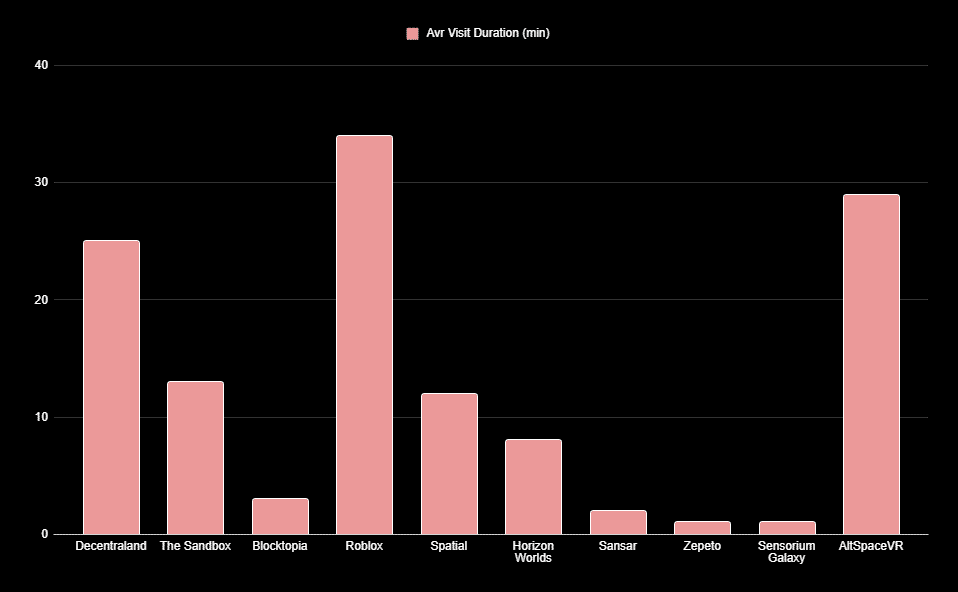
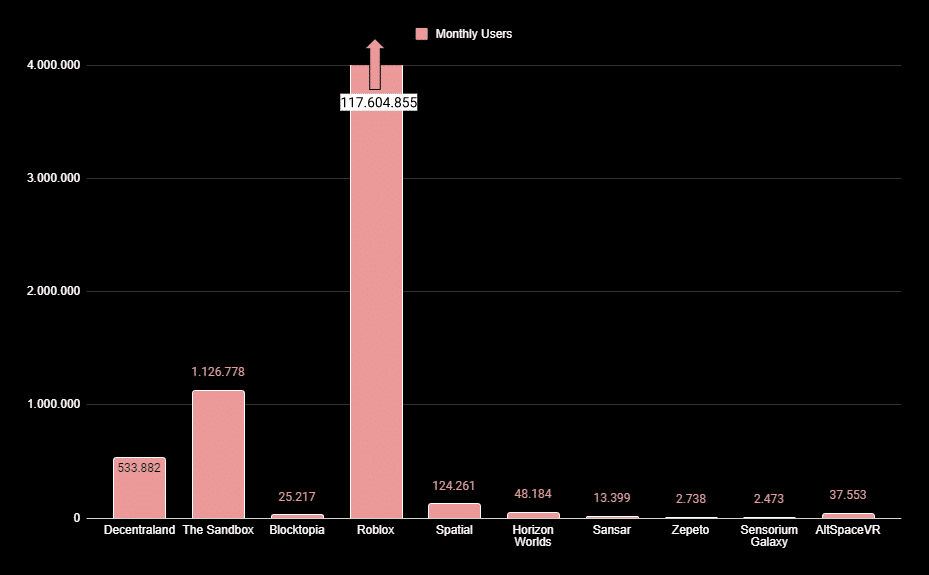
We know that all this information can be difficult to manage. Besides, if you don’t know anything about how to start in a metaverse it is logical that you won’t know which one to choose. That is why in this survival guide we have included the 10 newest and most interesting metaverses.
Decentraland

Welcome to Decentraland, or as we like to affectionately call it, the metaverse of the mountains. It is the most popular among companies, as it allows them to advertise their own products and services. And it doesn’t stop there: Decentraland is an open world, which means that anyone can enter without an invitation (we don’t like unfair exclusivism), create and customize their own avatars, interact with others and participate in all kinds of activities. It is a real parallel virtual world, where you can do almost everything you could do in the real world.
In appearance it is a 3D virtual world that creates an immersive experience. If you have paid attention to the lessons in the section on metaverse types, you will see that Decentraland, due to its characteristics, is consistent with the decentralized metaverse (‘Decentraland’, or what is the same ‘decentralized land’). This, as well as a play on words, means that the users are the owners of the products they buy within this metaverse, not the company or the creators.
They can buy or rent land where they are lords and masters of the place; they have total control and freedom over their little piece of land. In addition, Decentraland has a lot of tools to help you customize your space. The Builder lets you build anything within your terrain and software like Blender or Cinema 4D makes it possible to import, model and texture objects, as well as add NFTs purchased from the market.
And, as in any good capitalist society, this metaverse also has its own currency: we present the MANA, Decentraland’s €, which operates under the Ethereum network. The market price of MANA has been €0.74 since September 14. If you are interested, you can get a modest plot of land from 3.500 – 4.500 MANA and make your duplex apartment with attic and terrace. If you get too high you can put a garden with a pool and a slide, which is always very distracting.
The advantages of Decentralad have attracted many brands, which are already present in this virtual reality, such as Samsung, Atari or Coca-Cola. The fashion industry is not left out of the metaverse: Nike, Balenciaga, Gucci or Ralph Lauren are here to stay and to make sure your avatar is not underdressed in the metaverse. Because yes, you can buy their virtual outfits. In fact, in March of this year this virtual reality celebrated its own
Fashion Week
with great success.
We can’t help but wonder: what is the average user of this metaverse like? The studies comment that they tend to have a curious profile and are entering these virtual worlds for the first time. Since he doesn’t know what he might encounter or what a metaverse is capable of, he doesn’t see it as ‘serious’, but as entertainment. It has the perspective that it is like a virtual reality game, not like a world that can recreate our own and where you can carry out activities that affect your real life.
Before he/she gets to discover all that he/she can do in a universe like Decentraland, the user will normally be rather passive and cautious, as he/she does not know very well how the metaverse works and goes with caution. First you will observe what other users are doing and start copying, and then you will create your own, more personal identity. They may be familiar with cryptocurrencies and blockchain, but will not go much further in terms of knowledge of the metaverse.

As we have already mentioned, they conceive it as a game, so they probably perform activities that allow them to meet other avatars and interact, such as attending events or visiting exhibitions of corporate or personal brands, but in a non-interactive way; they will not participate, they will only observe. Virtual worlds are still a mystery to most Internet users, so it makes sense for them not to dive headfirst into the pool and first investigate whether the metaverse offers what they want or need.
Sandbox
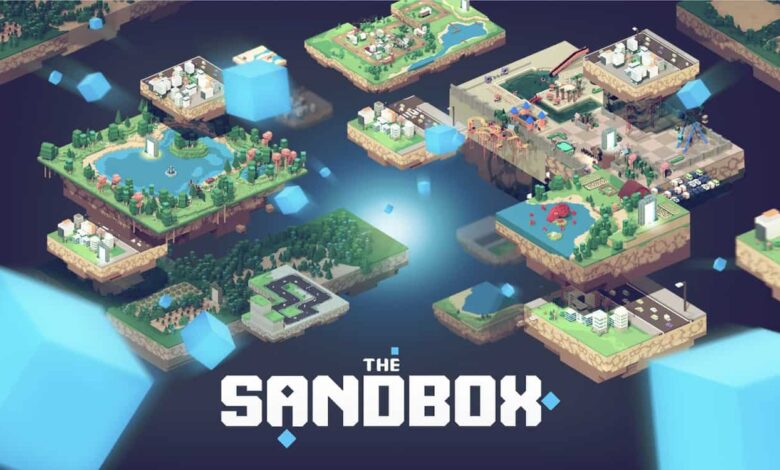
Like Decentraland, Sandbox is another decentralized metaverse in which users can build, interact with other avatars and monetize their experience on the Ethereum blockchain using SAND, the currency of this metaverse. It is also an open world (anyone can join). The objective of Sandbox is to become a play-to-earn platform, in which users obtain rewards or prizes in the form of tokens if they perform a task or activity. Of course, receiving these tokens is not free; although entry to the virtual world and permanence are free, if you want to win prizes you will need to have purchased an NFT Alpha Pass.
Sandbox, although it is a metaverse like any other, is more focused on the world of video games. Its appearance and the activities you can perform, as well as the brands that are present, are of that world. You can find some like Adidas, Ubisoft, Atari, Gucci or Square Enix, but you can also run into real-world celebrities like Paris Hilton or Snoop Dogg. In fact, you might run into a character from The Smurfs or The Walkiang Dead (hopefully not the zombies).
Sandbox allows you, like other metaverses, to customize your avatar and, in addition, to model and animate its digital assets with VoxEdit. You can also create NFTs and video games (with GameMaker), which you can monetize.
The average Sandbox user, unlike Decentraland, is a bit more into the world of the metaverse, perhaps because his/her background is usually that of a gamer who is attracted to new virtual worlds and everything he/she can do in them. You need some prior knowledge of cryptocurrencies, as you need to have a wallet to access the platform. They still see the metaverse as entertainment, but they are proactive: they interact with the experiences created by brands or specific users. They want to see what the metaverse is capable of and how it can entertain them.

Sandbox also lets you customize your avatar, as well as offering rewards for completing activities or missions. Undoubtedly, this metaverse is for people who are up to date and enjoy the continuous updates of the platform, which make the content innovate and improve.
Blocktopia

Welcome to Blocktopia, a virtual Blade Runner. This metaverse is a virtual skyscraper with 21 levels, all for their beloved community of Bloktopians (yes, they have a name for their fandom). Behind this platform is the Polygon network, which has built and supported this virtual world.
Blocktopia is based on 4 ‘blocks’ that serve as a guide for the new user:
- Learning. Cryptocurrency education and training.
- Winning. Users can obtain tokens by participating in activities (games, presentations…), real estate and advertising.
- Play. The platform has multiple interactive video games.
- Create. Users can customize their avatar, create scenes, artwork, challenges and much more.
This metaverse is more ‘professional’: although it has games and many activities in which the avatar can participate, users must have previous knowledge in cryptocurrencies and blockchain, and they enter Blocktopie with the aim of learning even more. They are also interested in a virtual entertainment space, where they can socialize or play video games. In fact, the brands that appear most often on Blocktopia are from the cryptocurrency world, such as Jake Paul and other crypto-influencers.
As in other virtual realities, money can be earned by owning real estate, earning advertising revenue, playing games or building networks. Blocktopia uses an innovative real-time 3D authoring engine to produce unique visualizations and user experiences. Undoubtedly, one of its great attractions is its aesthetics, reminiscent of video games or futuristic movies full of neon and bright colors.
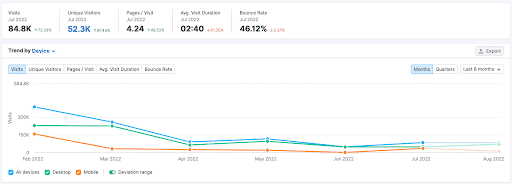
This user does see the metaverse as something educational and from which he/she can learn and benefit, but he/she does not want to give up entertainment. Blocktopia’s goal is to teach so that its players can then become independent in the world. The central focus will always be on cryptocurrencies. If you are not interested in the subject or if you are a company that does not intend to enter these worlds for the time being, Blocktopia is not the most recommendable for you.
Roblox
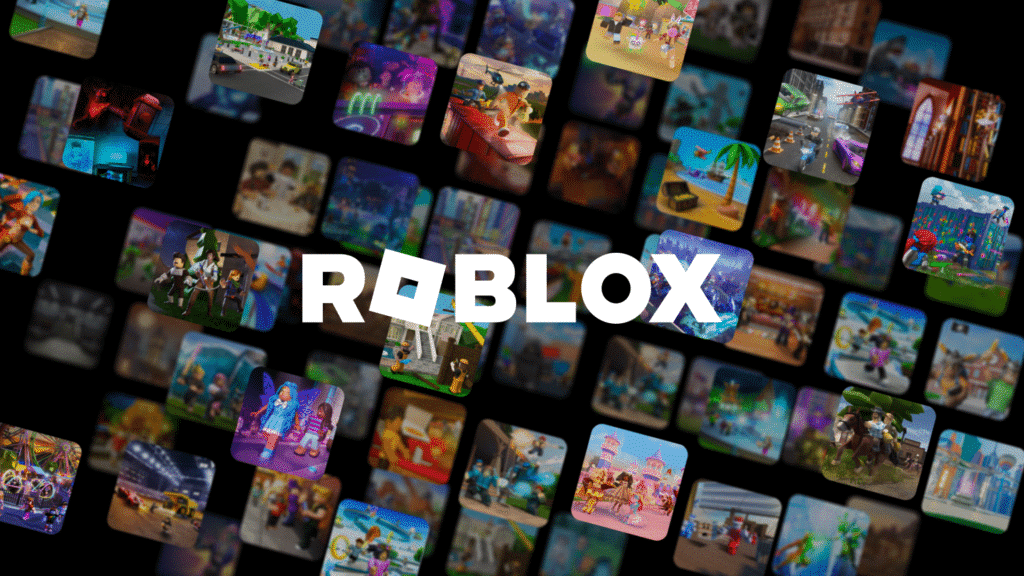
Roblox is a metaverse with a very clear objective: to play and create games. In this world, users can customize everything they want about their avatar and the environment around them with pieces of different sizes and materials. It is the Lego of the metaverse. Earlier we mentioned that avatars can create in-game games. No, we are not talking about the Matrix, but about Roblox Studio, an application with which users shape the environment and create games with simple programming. They can play and share their own games or choose games created by others.
However, in Roblox there is a fundamental difference with respect to the rest of the metaverses we have talked about so far: it is centralized, so it is controlled by an entity that obtains an amount from the profits of the universes created within Roblox. It remains, however, an open platform, with its own programming language (LUA) and currency (Robux).
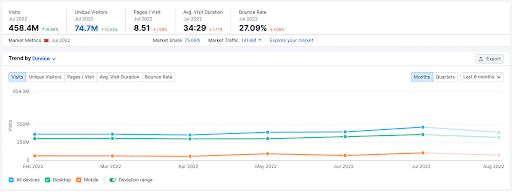
What brands can we already find in Roblox? Nike, Hyundai, Disney, Warner Bros, NASCAR, GUCCI… Have you noticed that some brands are related to the world of animated entertainment? This is because the player profile is usually childish. He sees the metaverse as a game, and thus interacts with it. As your target audience is children or teenagers, you don’t need to have much prior knowledge about the metaverse. In fact, the mechanics are very similar to any mobile game.
Spatial
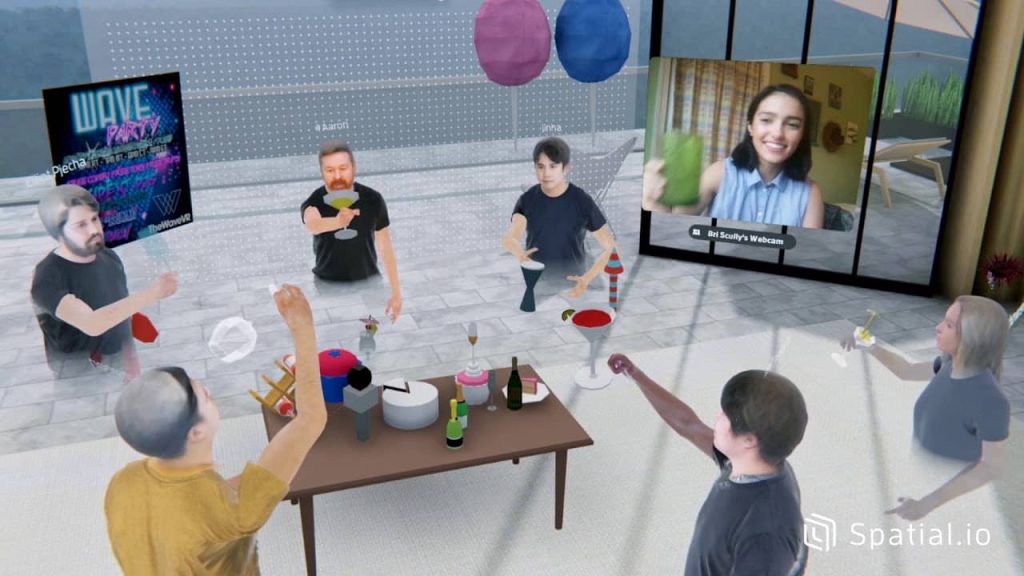
Spatial definitely has a different approach than other metaverses: its main objective is to provide cultural spaces in the metaverse for creators and brands. Undoubtedly, prioritizing culture is something we don’t see very often (neither in the real world nor in the metaverse), so this platform surprised us from day one. The only ‘but’ we could give it is that it is centralized, but considering the rest of its features we can forgive it. Like the other metaverses, it is open, so any user can create their own space, expose their creations and increase their visibility.
It is a space made to show the world what you are capable of. As a user, you can visit and interact with the spaces of other users or brands, as well as enter their website. It is compatible with Ethereum wallets to expose NFTs. Spatial itself has a
guide
on how to create an event. Or if you want, you can stop by the event spaces of brands like Vogue or McDonalds, where they showcase their latest creations (maybe you’ll also be inspired to create your own space).
Considering the characteristics of Spatial and the objectives it has in mind, you will understand that it is not a game environment. Users are professionals and see the metaverse as a source of inspiration and discovery of new trends. They do not want to be present in the metaverse just because it is fashionable or ‘just for the sake of being’, but to obtain information. They treat it like an art newsletter: they enter Spatial and catch up on the world of art and culture, but they also immerse themselves in the brands’ spaces, where corporations also exhibit their work and culture, in addition to exhibiting their own work.

Communication between avatars in Spatial is quite unidirectional, as users create their own gallery and receive visits from other interested people. It serves to give visibility to creations and keep up to date with what’s new in the art world, so you don’t need to have any experience in the metaverse or blockchain.
Horizon Worlds
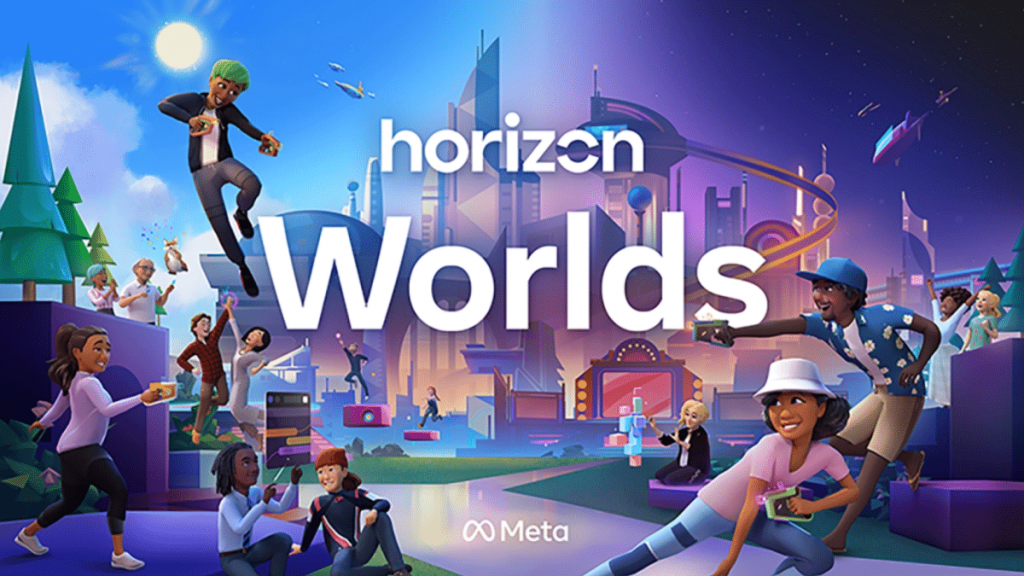
This metaverse is all about having fun. The ideals of your world are community, sociability and lifestyle. For this reason, they have decided to opt for an immersive and super-realistic experience thanks to Oculus (a virtual reality device) in order to gain access. What is the problem with this technology? It makes Horizon Worlds an inaccessible metaverse for many users.
The purpose of this reality is for you to have fun, to get together with your group of friends and go to concerts, sporting events or movies, all from home and in an ultra-real way. In fact, as many artists, such as Post Malone and Jordan Peele’s, are present in Horizon Worlds, you can enjoy concerts or similar experiences taken to the extreme offered by the metaverse technology. This world has the user at the center of everything and their enjoyment is the most important thing, so it is not usually the preferred platform for companies. In addition, as it is part of Meta, it is closely linked to its ecosystem and that always brings some difficulty or other.
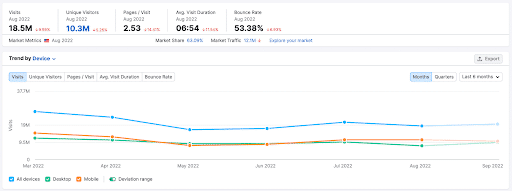
The ideal user is someone who is curious and already uses social networks as a way of socializing. He sees the metaverse as entertainment and wants to be the center of attention within the game. The main objective of Horizon Worlds is interaction with others. Users want to extend their personal life to a virtual platform. Here they can do things they do or would want to do in real life. To do this, they need a medium-high level of digital skills, especially for the use of virtual reality glasses.
Sansar
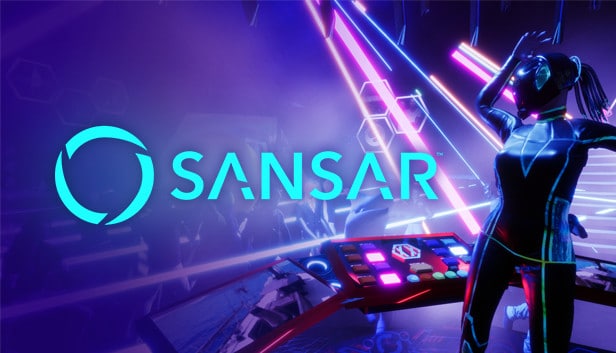
Sansar is the party zone of the metaverse. With its ultra-immersive and super-realistic design, this virtual universe focuses on providing entertainment through events (concerts, parties, movies…). You can access it from a computer, which makes it possible for millions of people around the world to get an avatar in this metaverse (making things easier is always good).
Users can watch the amazing live performances of their favorite artists without having to travel to their shows, meet new friends, get merchandise, take selfies and dance. You can basically do almost anything you could do in reality but something big and without leaving home.
The aesthetics are based on fantasy worlds and clubs taken from science fiction. It is possible to unlock special powers and access exclusive encounters only with a VIP ticket. This care in the aesthetics makes its main audience to be users with audiovisual concerns. They want to see what this new technology can do for them and what it is capable of. They come out of curiosity and stay for the experience. They can also be gamers, although it is not a must.

Sansar offers a social community where avatars can dance, shop, attend events. Therefore, the player has to be active in the different worlds. Of course, you have to come with some homework done, you need a medium-high level of digital knowledge (you have to download the program and learn how it works).
Zepeto
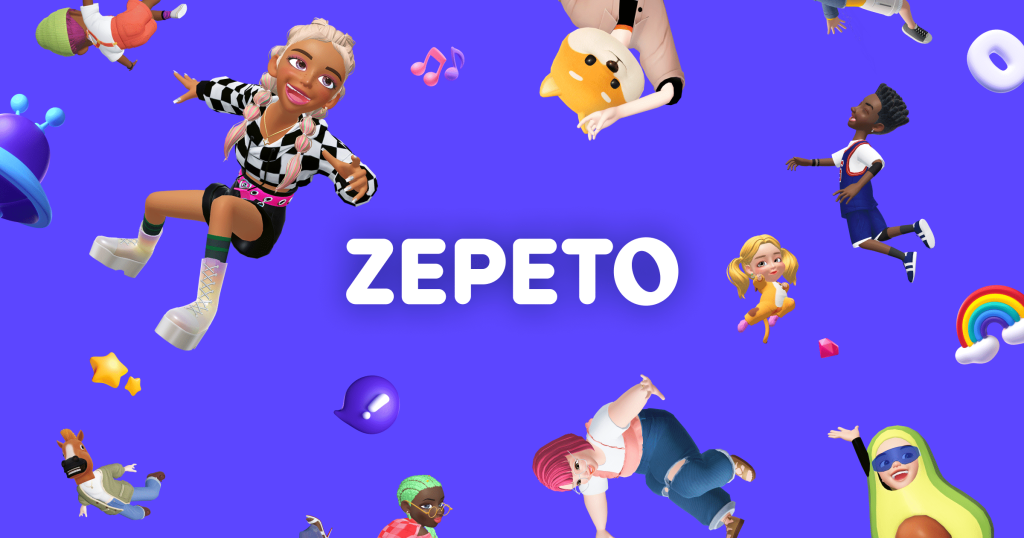
It may be the metaverse that took the least time to reach the general public. Perhaps because it was a universe that quickly connected with young people and, above all, with fandoms. Zepeto has a very interesting approach: celebrities and brands create their own events. In fact, this virtual environment allows them to have deeper interactions with their fans. Clothing brands (GUCCI) and music bands (Blackpink) are the most present celebrity collectives in this metaverse, which moves thousands of people to want to be part of Zepeto, since, in the end, they use it as a way to unite their community, offer exclusive products and show their new merchandising.
They designed this metaverse in such a way that it could be accessed with any cell phone device; it reaches almost any user. They can customize their avatar and buy special items, as well as create and sell their own. The only drawback is that only fashion items can be created. However, as in other metaverses, users can interact with the world around them and with the objects they encounter, as well as complete quests and obtain rewards for doing so.

The user’s goal is to have fun, interact with other avatars and, above all, discover more about their favorite bands and brands. The attitude of the users is usually very active; you always want to be part of the game and ‘make your mark’. In addition, the ease of use of this metaverse is very appealing, since the digital level you need is medium to low. It’s like a classic mobile game.
Sensorium Galaxy
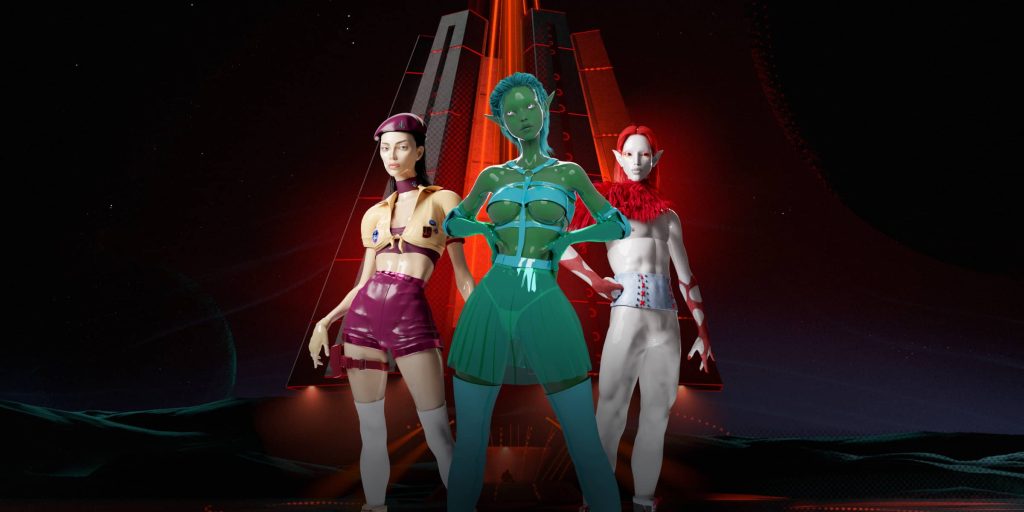
This metaverse will be a favorite of people who love AI and futuristic environments. Sensorium Galaxy offers an experience of self-expression based on fantasy and out of this world environments. Its main point is music, especially electronic music, so the goal of the metaverse is to create concerts that are much more than just listening to music: it is an experience that mixes fantastic worlds of Ghost in the Shell dyes with artificial intelligences customized to the limit.
Users tend to have cultural concerns (especially musical ones) and enjoy everything that technology can offer them in terms of art. The environments of this virtual universe are of high quality and are very well cared for, so players can experiment with self-expression. In addition, they can create their own shows based on experience.
The ideal player is a person who wants to participate in the world, interact and be part of it. They want to attend all kinds of artistic and musical performances and see what this world can offer them. At the moment the focus of the game is the electronic music shows, but seeing the rise of metaverses and the visual care of Sensorim Galaxy we have no doubt that it will become one of the richest and most cared metaverses in a few years.

However, if you want to enter this universe, start studying: participating in Sensorium Galaxy requires a high level and understanding of the metaverse and the AI. You know what they say: it’s never too late if it’s too late.
Altspace VR
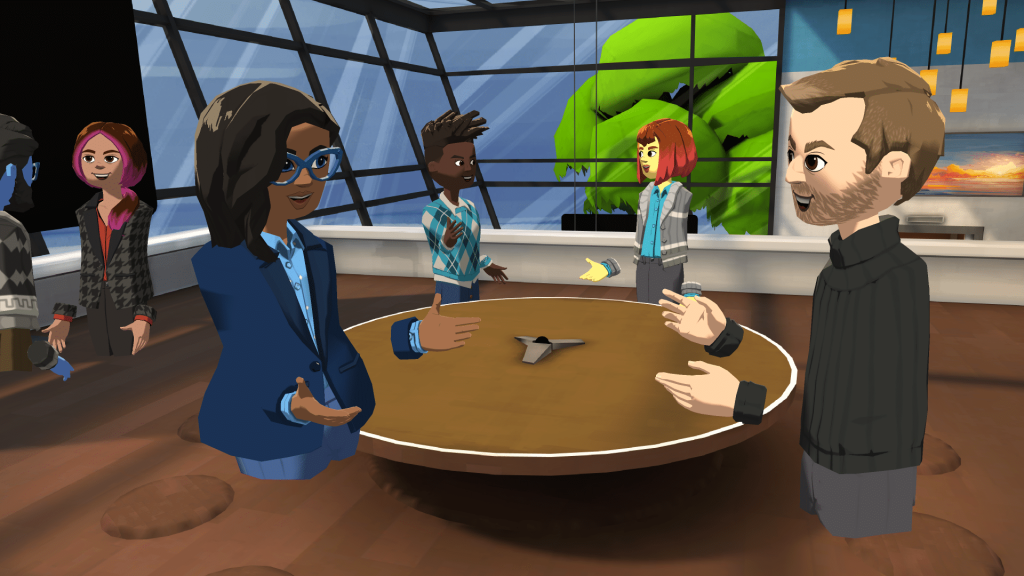
Altspace VR is that metaverse that may not have the best interface, but is incredibly functional for companies or corporate events. This virtual environment is open and centralized in which virtual events hosted by brands, companies, artists, etc. can be created. Users can visit them or create events themselves, interact with the experience and with the rest of users who are part of it (if they wish, of course).
In fact, the platform has a very interesting gadget: it offers a calendar that announces current and future events, so you only have to consult it to find out what’s going on in Altspace. These meetings can take place in different virtual worlds, from per-generated environments (streets, rooftops) to more fantastic spaces. It all depends on the imagination of the host.
Although users do not need to have any experience in the metaverse or blockchain, they do need to download an application to enter the Altspace. In addition, they will first have to design an event, building it with Unity or with a pre-designed template. The good thing about this metaverse is that it offers you both options.

Looking at all the options for creating events available in Altspace, we can conclude that the ideal user is a professional, that is, he/she goes to the metaverse to obtain information and attend meetings of all kinds, especially in the world of art and culture, but also in specific brand spaces (where corporations can exhibit their work). The objective is not to interact with other avatars, but to discover or expose.
The rooms
Now that we have formally presented the 10 most popular metaverses, let’s see which one would be the most suitable for a company or corporation. For this, we will make a small summary of each one of them; so, if you only want to know which virtual environment is the top one for companies, you can read only this part (even if we haven’t told you before…). Let’s recap:
- Decentraland. It is on its way to becoming one of the most popular metaverses, although as it stands now, from a business point of view it may not be the most appropriate. It requires users to have a cryptocurrency wallet to enter the metaverse, although they can register as visitors. This feature may put off many users who, although they like your content and presence in the metaverse, do not want to be forced to own cryptocurrencies.
- The Sandbox. It is clearly a game-centric environment and not a professional and/or work environment, so we rule out the possibility of hosting a company in this metaverse.
- Blocktopia. The problem with this metaverse is that it has a very well defined target: users interested in the world of cryptocurrencies. This condition represents a very high barrier to entry for other profiles. Also, as a company, we may not be that interested in that world.
- Roblox. Something similar happens to Sandbox: it is a universe whose focus is the game. In fact, its target audience are children or teenagers, so from a business point of view, discarded.
- Spatial. This may be one of the most attractive metaverses for companies: it has a low barrier to entry and is easy to navigate. In addition, customized spaces can be easily created and used for events or meetings. Its interface is also very practical and the possibility of holding meetings makes it even more attractive to companies.
- Horizon Worlds. Companies, for your business, this metaverse is 0 recommended. In addition to being based on virtual reality technology (which means that all users need to have VR glasses), it is a world centered on musical events.
- Sansar. It’s a bit the same as with Horizon Worlds: they are metaverses specialized in a specific sector and do not leave much room for other types of activities. In this case, Sansar is characterized by the audiovisual world.
- Zepeto. If you are a fashion brand, this is your metaverse. If not, read on.
- Sensorium Galaxy. It is only for brands or people who want to make their performance or classes immersive.
- Altspace VR. This metaverse has several opportunities for companies: it has a low barrier to entry and it is very easy to enter and navigate this universe. In addition (something that is always of interest to companies) it allows you to create spaces and use them for events.
Dear Company…
An increasing number of companies are seeing the potential of metaverses and want to join these virtual worlds. Without a doubt, the advantages are astounding: a new, completely ethereal space in which to reach people all over the world. And since new things are scary, it is normal to start testing the waters in ‘easy’ metaverses, such as Altspace VR or Spatial. Its great UX helps both visitors and creators, making the work much easier and giving the option to create 1 or several events or meetings at the same time. Not only that: they create community, a space where people with the same interests can meet and catch up on all the news in the sector.
Undoubtedly, the metaverse for companies is just the tip of the iceberg of all the virtual space technology to come. Large technology sectors are making metaverses evolve little by little, as well as making them more accessible and complete. This is one of the most important technological advances of our era. If you have a company, we recommend you to be very attentive to what the metaverse can offer you. But, if you don’t want to complicate your life that way, you can follow us and read the posts we will be uploading to be updated on all the evolutions of what promises to be one of the most relevant changes of the last years 😉
